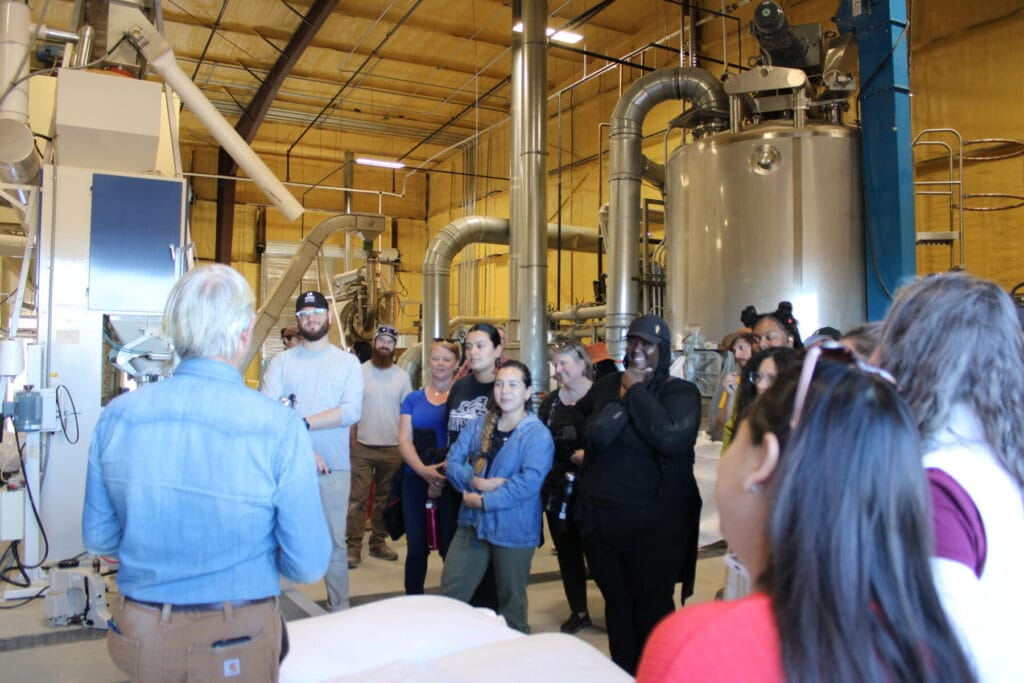
By Aaron Poplack, ASU sustainable food systems graduate student
In December 2023, our cohort of Sustainable Food Systems graduate students had the opportunity to travel to Camp Verde, Arizona, where we learned firsthand about the multi-sector “farm to growler” collaboration that is Sinagua Malt. Sinagua Malt is a benefit corporation and market-based river conservation solution founded by Chip Norton and Steve Ayers in 2016 in partnership with The Nature Conservancy.
The Verde River
John Ford, River Project Manager at The Nature Conservancy, opened our tour by ensuring we understood that any story about Sinagua Malt must begin with the Verde River. The Verde River is about 190 miles long, flowing from its headwaters in the Chino Valley, through the Verde Valley, and on to Phoenix. Like other rivers in the Southwest, the Verde faces various existential threats: climate change, agricultural diversions, increasing groundwater development and adjudication, and a rapidly growing metropolitan population in Phoenix. Fortunately, there are also a variety of solutions. Improving irrigation efficiency, conservation easements, groundwater protection, and crop conversion are all tools for maintaining river health.
Chip quickly emphasized that each solution is just one piece of the puzzle: “There’s no silver bullet. It’s the sum of these projects being done in a coordinated manner that makes a difference”.
River Conservation through Crop Conversion
Sinagua Malt was founded to help make one of those solutions – crop conversion – a more viable option for farmers in the region. Crop conversion is the practice of shifting agricultural production away from the water-intensive crops that the region has historically grown, like alfalfa, towards less water-intensive crops like barley. Alfalfa is a summer crop, with its peak water use occurring in June when river flows are already the lowest, with major impacts on fish and wildlife habitat. Malting barley is harvested in July and has very little summer irrigation.
While the Verde Valley has been a historic farming region since the 1800s, it’s not an agriculturally dense region. That means engaging just a few farms in conservation practices can be the difference between a dry river and a river with a foot of water. Finding mutual interest and building that trust has been the key to that engagement for Sinagua Malt. When asked how we can increase collaboration between farmers and environmental conservation organizations, John Ford was adamant that you have to “start off with small trust building projects, even if there isn’t a huge conservation value. Now we’re working on large conservation projects that scale”.
Adding Value and Finding a Market
To make crop conversion worthwhile, Norton and Ayers realized that they needed to solve the market side of the production equation. Barley had been identified as an ideal conversion crop for the growing region. Still, feed barley for animals is sold at commodity prices that are too low to support the conversion of meaningful acreage out of alfalfa. To make barley a viable conversion crop, the partners needed to find a way to get closer to the end of the value chain. With breweries and distillers in Arizona looking for local malts, the idea of growing malting barley and building a malting facility to roast and distribute the barley began to take shape. Arizona Wilderness Brewing has been a crucial partner from the beginning, allowing Sinagua to know they had a stable market as they piloted and scaled their production.

Kim Schonek, Verde River Water Transactions Manager at The Nature Conservancy, and Norton had been using Ford’s trust-building strategy with local producers. In 2016, they leveraged their good relationship with Hauser and Hauser Farms to get a test batch of malting barley planted.
After getting another malt operation to roast a test batch and distribute the results to a handful of local breweries, the pilot project slowly grew. Sinagua scaled up to 150 tons of base malt production in 2022, along with a handful of specialty malts. They eventually hired Russ Mayhew as their first full-time maltster, and in late 2022, Sinagua completed the installation of a three-kiln malting system. Each kiln can hold 22,000 pounds of barley, offering the opportunity to roast up to 1700 tons of malt annually. That’s a scale at which crop conversion could make a difference for the base flows of the Verde River.
What’s next for Sinagua Malt?
In 2024, Sinagua hopes to add an on-site coffee and pastry shop and then a taproom where they’ll sell kombucha and mead (made with honey from bees that Mayhew keeps) and possibly beer made with their own malt. They’re also exploring producing other value-added products. They also plan to install a wastewater treatment plant on-site to allow for water reuse and hope to add solar panels to help power their malting equipment.
Sinagua Malt weaves river conservation, agriculture, regional food processing, and sustainability together. During our visit, Chip noted that the most important element of Sinagua’s success was the spirit of collaboration that allowed them to create one relatively simple solution (crop conversion) to a complex problem (balancing river conservation with the region’s agricultural economy): “These projects are hopelessly entangled. We’re creating a Gordion knot.” The story may have started with the Verde River, but Chip and his team hope that it ends with inspiration. Beyond keeping the Verde flowing, they hope their innovative approach motivates farmers and conservation organizations across Arizona to continue building trust and collaborating.
This blog is part of a series from the Swette Center's annual Arizona Food and Farm Immersion, a required course in their two graduate programs. Students tour the state, meeting with farmers, ranchers, entrepreneurs, government staff, and non-profit leaders.